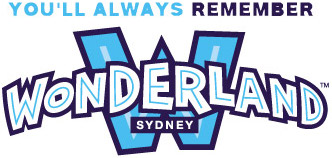With a capital injection of $65 million, Wonderland began life in December 1985 with the financial backing of the NSW State Superannuation Board (33.75%), James Hardie Industries (23.75%), Leighton Holdings (18.75%) and Taft Broadcasting (23.75%). The initial goal was to capture the family entertainment market in Sydney with the trial of an American-style theme park for Australia.
With backing from the State Government, Wonderlands' site at Eastern Creek (then still considered Minchinbury) was easy to obtain with full support from Blacktown Council citing the employment and tourism opportunities it would bring to the area. This location was chosen to be central to urban sprawl predicted to spring up within 20 years and a prime location alongside the M4 motorway being the major arterial freeway into Western Sydney.
 |
| The Wild Beast from Canadas' Wonderland. The Bush Beast was a replica of this ride. |
Construction of the park was performed by Taft Broadcasting which also owned the Kings Entertaiment Company. Kings operated a variety of theme parks in the United States and Canada prominently 'Canada's Wonderland' and 'Kings Island' in Ohio.
Many rides such as the Bush Beast, Beastie and Zodiac were directly sourced second hand from these parks or were replicas of rides already there. The theming of Wonderland (especially Hanna Barbera land) was based directly off of Canada's Wonderland.
 |
| Looking down into what will become Gold Rush |
Construction of the park begun in 1983 and was completed within 2 years for the parks opening on December 7th of 1985. Direct competition at the time was with 'Luna Park' and to a lesser degree, 'Mt.Druitt Waterworks'. Attendance figures were projected to be around 1.6 million people in the first year but by August of 1986 Wonderland had fallen quite short with only 600,000 visitors walking through the gates of the park.
 |
| Tim Fisher looking up and The Bush Beasts Fan Curve |
Wonderlands' official opening was on December 7 1985 where Premier Neville Wran turned on the parks waterfall alongside Yogi Bear to signal its opening. Premier Wran was then escorted around the park by Managing Director Keith James and Kings Entertainment Co-President Nelson Schwab.
Also present at the opening ceremony was Hanna Barbera co-founder Bill Hanna. The Hanna Barbera theme played a large part in Wonderland with 'Hanna Barbera Land' being an easily recognisable part of the park. It was criticised early on for being based on very outdated cartoons and American 'hand me downs' yet was a hit with children and parents alike.
Originally Wonderland started with just three themed lands: Medieval Faire, Goldrush, and Hanna-Barbera Land. Medieval Faire was later renamed International Village when rides orginally placed there (such as Sea Demon) were relocated (Sea Demon is better known as HMS Endeavour). The addition of other attractions did not fit with the original Medieval theme and also contributed to the renaming to International Village.

One of the most interesting parts during the construction of Medieval Faire was the 'Wrecked Ship' which was built in a genuine shipyard, loaded onto a semi-trailer and transported into Wonderland in the early hours of the morning down the Great Western Highway.
This attraction was sponsored by Tooheys and in its prime featured a stunt show with regimental soldiers and pirates duking it out.
Marketing by the park prominently used this stunt show in its advertisements and you may remember television ads in the late 80's/early 90's featuring footage from this show (remember the pirate falling off the mast?).
With the introduction of Transylvania in 1992, rides and attractions from the International Village were yet again relocated and the area was finally renamed Old Botany Bay. The Sea Demon was renamed HMS Endeavour in 1990 and moved into Goldrush. The Jousting Ring and Bountys' Revenge were the only rides remaining.
Over the next decade Wonderland developed steadily much like any other theme park. It is well known in the amusement industry that for any theme park to succeed, capital injections must be made every 2-3 years which are used for the purchase of new attractions. Wonderland was no different and the most high profile rides that were installed in the park after its initial construction were The Demon (1992), Space Probe 7 (1995) and The Beach (1988).
A grand plan for Wonderlands future was that the 219 hectares of land that it sat on would be further developed into a larger resort with golf course, seperate waterworks area (which became The Beach), accomodation and parkland. It's conjecture and rumour that Rooty Hill RSL strongly opposed this development claiming that it would harm its interests in the area. Hence, zoning changes that would have been required to make these visions possible never did occur.
It's at this point that pundits believe led to Wonderlands decline. So critical were these developments that investors in Wonderland came to the stark realisation that their investment would go nowhere. Especially after the initial support from Blacktown City Council and the State Government. After having incurred losses of $15 million and having the parks success slowly decline, Wonderland was sold in 1997 to the Kuala Lumpur-based unit trust, Sunway Australia. Sunway Australia bought all the founding shareholders' stakes and the management company, Sydney Theme Park.
From the time Sunway took over and until the parks closure the only major attraction added was the Skyrider. It's often claimed that the park was run on 'remote control' with the parent company indifferent to any real development of the park. Much debate is had as to the real reason why Sunway purchased Wonderland but the most popular reasons are either a clumsy attempt at cashing in on the Australian tourism market or more sinister the intention to let the park decline and cash in on the land. Both of these theories are extremely plausible and a section of this site is devoted to analysing the real reasons.







